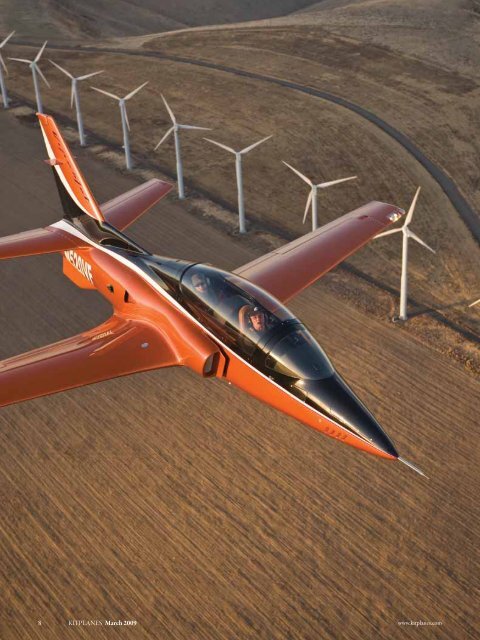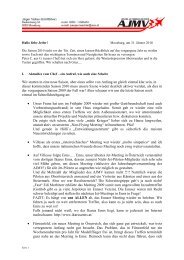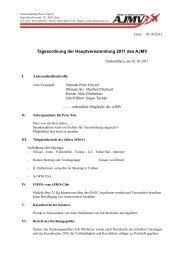A turbofan Viper is coming to replace the rowdy, thirsty ... - AKATEC IT
A turbofan Viper is coming to replace the rowdy, thirsty ... - AKATEC IT
A turbofan Viper is coming to replace the rowdy, thirsty ... - AKATEC IT
You also want an ePaper? Increase the reach of your titles
YUMPU automatically turns print PDFs into web optimized ePapers that Google loves.
8 K<strong>IT</strong>PLANES March 2009<br />
www.kitplanes.com
<strong>Viper</strong>Jet Redux<br />
A <strong>turbofan</strong> urbofan <strong>Viper</strong> <strong>is</strong> <strong>coming</strong> <strong>to</strong> <strong>replace</strong> <strong>the</strong> <strong>rowdy</strong>, <strong>thirsty</strong> turbojet version—here’s <strong>to</strong> one last ride ride.<br />
Whe<strong>the</strong>r our airplane-building budget<br />
supports a Pietenpol or an RV-8,<br />
most folks who have <strong>the</strong> gumption and<br />
<strong>the</strong> skill <strong>to</strong> build and fl y <strong>the</strong>ir own airplanes<br />
were not born sucking on a silver<br />
spoon. Most of us in <strong>the</strong> homebuilt world<br />
grew up reading about BD-5s or Teenie<br />
Twos in Popular Science and Mechanics<br />
Illustrated. And most of us have<br />
reached beyond our grasp <strong>to</strong> build and/<br />
or fl y airplanes far more soph<strong>is</strong>ticated<br />
than we ever dreamed possible when we<br />
were parsing <strong>the</strong> words in those Readers<br />
Digest-sized science magazines so many<br />
years ago. It’s <strong>the</strong> nature of progress and<br />
aspiration.<br />
Without that ability <strong>to</strong> imagine, we<br />
would never build or buy an airplane<br />
we assembled or put <strong>to</strong>ge<strong>the</strong>r by o<strong>the</strong>rs<br />
in a garage, much less fl y it. So let’s relax<br />
our cynical side that says, “I could never<br />
aff ord <strong>to</strong> build nor have <strong>the</strong> skills <strong>to</strong> fl y a<br />
<strong>Viper</strong>Jet” and do some of that youthful<br />
dreaming that served us so well and has<br />
brought us so far. What could it hurt?<br />
Believe me, it’s fun!<br />
Recalling Reno<br />
I fi rst saw <strong>the</strong> <strong>Viper</strong>Jet at <strong>the</strong> Reno Air<br />
Races in 2006. I walked by and marveled<br />
at <strong>the</strong> little airplane with a General<br />
Electric J85 engine. Th e J85 <strong>is</strong> <strong>the</strong> military<br />
version of <strong>the</strong> CJ-610, <strong>the</strong> engine<br />
that powered <strong>the</strong> -20 series Learjets<br />
and <strong>the</strong> Jet Commander as well as some<br />
o<strong>the</strong>r 1960s vintage business jets. In <strong>the</strong><br />
great tradition of <strong>the</strong> Pontiac GTO or<br />
Pho<strong>to</strong>s: Richard VanderMeulen<br />
Mustang Cobra, <strong>the</strong> J85 <strong>is</strong> powerful,<br />
loud and sucks down Jet A like <strong>the</strong>re’s<br />
no <strong>to</strong>morrow.<br />
I fl ew <strong>the</strong> Jet Commander years ago,<br />
and while I fell in love with its instant<br />
power response and bulletproof dependability,<br />
I learned early that fl ying pure jet<br />
engines was an exerc<strong>is</strong>e in prefl ight planning<br />
and judicious fuel management. I<br />
fl ew with a pilot named Keith, who grew<br />
up fl ying pure jet engines, and he taught<br />
me <strong>the</strong> rules. Rule No. 1 was you are out<br />
of gas and on fi re at brake release, and<br />
<strong>the</strong> situation deteriorates from <strong>the</strong>re.<br />
Rule No. 2 was never, ever let ATC fl y<br />
your airplane. Unnecessary vec<strong>to</strong>ring or<br />
an early descent meant landing with <strong>the</strong><br />
low-fuel lights fl ashing, or worse.<br />
When I saw <strong>the</strong> compact <strong>Viper</strong>Jet at<br />
Reno, I knew it was an animal. I knew,<br />
<strong>to</strong>o, that it was not for <strong>the</strong> faint of heart,<br />
and I wanted desperately <strong>to</strong> fl y that<br />
little rocket ship. But as far as building<br />
or buying one, that was a dream that<br />
involved lottery tickets, and I don’t buy<br />
lottery tickets. Th at didn’t s<strong>to</strong>p me from<br />
dreaming about fl ying <strong>the</strong> <strong>Viper</strong>Jet.<br />
When <strong>the</strong> call came, “Would you be<br />
willing <strong>to</strong> go <strong>to</strong> Pasco, Washing<strong>to</strong>n,<br />
and fl y <strong>the</strong> <strong>Viper</strong>Jet?” it was a short<br />
conversation. I packed my hard hat and<br />
a Nomex fl ight suit. I planned <strong>to</strong> fl y a<br />
pro<strong>to</strong>type with parachutes and utilitarian<br />
cockpit—much like <strong>the</strong> airplane<br />
K<strong>IT</strong>PLANES® reported on in March<br />
2006. Arriving <strong>the</strong>re I found an airconditioned<br />
airplane with glove lea<strong>the</strong>r<br />
The fi ghter-style tip-up canopy comes down via a low-tech strap. Hey, it works...<br />
BY DOUG ROZENDAAL<br />
interior and rosewood inlaid circuitbreaker<br />
panels. When demo-pilot Greg<br />
Bennett appeared in Levi’s and a ball<br />
cap <strong>to</strong> fl y with me, I realized <strong>the</strong> airplane<br />
was far<strong>the</strong>r down <strong>the</strong> development path<br />
than I expected.<br />
Continued Development<br />
Th e <strong>Viper</strong>Jet project has been in <strong>the</strong> making<br />
for a while. Bro<strong>the</strong>rs Scott and Dan<br />
Hanchette started <strong>the</strong> company in 1995<br />
with <strong>the</strong> plan <strong>to</strong> build an airplane called<br />
<strong>the</strong> <strong>Viper</strong>Fan, which was <strong>to</strong> be a p<strong>is</strong><strong>to</strong>npowered,<br />
propeller-driven pusher. Early<br />
in <strong>the</strong> program <strong>the</strong> bro<strong>the</strong>rs saw <strong>the</strong> diffi<br />
culty of producing <strong>the</strong> drive train for a<br />
pusher prop. “If we had a problem with<br />
<strong>the</strong> drive system, we fail,” Scott said.<br />
K<strong>IT</strong>PLANES March 2009 9
<strong>Viper</strong>Jet continued<br />
Th e bro<strong>the</strong>rs were involved in buying<br />
and selling French Fouga Mag<strong>is</strong>ters. Th ey<br />
called an associate, and two weeks later a<br />
Turbo Mecca jet, <strong>the</strong> same engine that<br />
powers <strong>the</strong> French jet trainer, arrived.<br />
Th irty days later <strong>the</strong>y were taxiing.<br />
Th e fi rst fl ight was in 1999. Th ey fl ew<br />
for a year and <strong>the</strong>n switched <strong>to</strong> a T-58<br />
turboshaft from a CH-46 helicopter.<br />
Th e drive portion of <strong>the</strong> engine was<br />
<strong>replace</strong>d by a tailpipe, converting <strong>the</strong><br />
shaft engine in<strong>to</strong> a jet with 700 pounds<br />
of thrust. Th at engine was underpowered,<br />
and when <strong>the</strong> military gave <strong>the</strong><br />
fi refi ghters fi rst chance at <strong>the</strong> surplus<br />
engines, <strong>the</strong> supply dried up and ano<strong>the</strong>r<br />
engine choice was needed.<br />
Fortui<strong>to</strong>usly, a Lear 23 landed at Pasco<br />
one day. Th e bro<strong>the</strong>rs measured <strong>the</strong><br />
engine and realized it would fi t, and it<br />
would provide more than enough thrust.<br />
At that point <strong>the</strong>y had sold fi ve kits. “We<br />
upgraded those kits <strong>to</strong> <strong>the</strong> MKII confi guration<br />
(with a carbon-fi ber wing) at no<br />
charge,” Scott said. Th e fi rst fl ight of <strong>the</strong><br />
MKII was on June 12, 2005.<br />
Winging It<br />
Th e MKII airplane has 25° of wing<br />
sweep in <strong>the</strong> leading edge and 6° in <strong>the</strong><br />
trailing edge, but <strong>the</strong> airplane handles<br />
and fl ies like a straight-wing airplane.<br />
All of <strong>the</strong> controls are actuated by pushrods<br />
except <strong>the</strong> rudder, which has cables.<br />
Th e nosewheel casters, and <strong>the</strong> gear, fl aps<br />
and speed brakes are electro/hydraulic.<br />
Clever features are incorporated<br />
throughout. Some of <strong>the</strong> most ingenious<br />
are <strong>the</strong> electromagnetic landing-gear-up<br />
locks. Th e down-locks are integral in <strong>the</strong><br />
actua<strong>to</strong>rs, using a ball/collar system that<br />
snaps down by ei<strong>the</strong>r hydraulic pressure,<br />
carbon dioxide blow-down or gravity,<br />
and are released by <strong>the</strong> hydraulic pressure<br />
on retraction.<br />
Th e cockpit looks more like a luxury<br />
car than a hot-rod jet—a big change from<br />
<strong>the</strong> previous iteration of th<strong>is</strong> aircraft .<br />
Th e canopy <strong>is</strong> rear hinged and opens<br />
manually on a gas strut, pulled down by<br />
a convenient and simple hanging strap.<br />
Th e canopy hinge seems strong enough<br />
<strong>to</strong> handle <strong>the</strong> strongest winds; locks are<br />
robust and designed <strong>to</strong> hold <strong>the</strong> 5.5 psi<br />
cabin diff erential that will be in subsequent<br />
airplanes. Th e limited amount of<br />
panel space in <strong>the</strong> front cockpit <strong>is</strong> used<br />
effi ciently by a pair of Op Technologies<br />
integrated EFIS screens that include<br />
navigation, com and engine instrumentation.<br />
Th e rear cockpit has a third EFIS<br />
panel integrated with <strong>the</strong> front cockpit.<br />
Th e airplane always had a tail stand<br />
in place, and <strong>the</strong> crew at <strong>Viper</strong>Jet were<br />
careful <strong>to</strong> tend <strong>the</strong> nose when it did not.<br />
Without <strong>the</strong> tail stand, and with no passengers<br />
in <strong>the</strong> airplane, <strong>the</strong> weight on <strong>the</strong><br />
nosewheel was minimal. A step slides in<strong>to</strong><br />
a receptacle on <strong>the</strong> left side for boarding,<br />
and <strong>the</strong> front cockpit <strong>is</strong> comfortable. I<br />
was relegated <strong>to</strong> <strong>the</strong> rear seat, which was<br />
also comfortable, with good head and<br />
legroom, but <strong>the</strong> canopy longerons were<br />
tight just above my elbows.<br />
Th e battery <strong>is</strong> adequate for starting<br />
<strong>the</strong> turbo-jet, but <strong>the</strong> J85 and <strong>the</strong> CJ-610<br />
are single-shaft engines, and <strong>the</strong> starter<br />
must spin <strong>the</strong> entire rotating element;<br />
using ground power ensures cooler starts<br />
and lower engine maintenance costs.<br />
Starting <strong>is</strong> simple: Turn on <strong>the</strong> boost<br />
pump, <strong>the</strong> igniter and <strong>the</strong> starter. When<br />
<strong>the</strong> engine reaches 10% rpm, turn on <strong>the</strong><br />
fuel and moni<strong>to</strong>r <strong>the</strong> Internal Turbine<br />
Temp (<strong>IT</strong>T) for a hot start. When <strong>the</strong><br />
engine <strong>is</strong> idling, <strong>the</strong> starter becomes <strong>the</strong><br />
genera<strong>to</strong>r, <strong>the</strong> ignition <strong>is</strong> turned off , and<br />
<strong>the</strong> fi re <strong>is</strong> self sustaining.<br />
Gulp...<br />
Even at idle power <strong>the</strong> J85 burns 75 gallons<br />
per hour. Th at <strong>is</strong> not a m<strong>is</strong>print. Th e<br />
airplane holds only 300 gallons in three<br />
tanks, so once <strong>the</strong> engine <strong>is</strong> running,<br />
getting airborne becomes a priority.<br />
Little additional thrust <strong>is</strong> needed for<br />
taxi, and once <strong>the</strong> airplane <strong>is</strong> moving it<br />
rolls easily. Th e rudder seems eff ective at<br />
low speeds, and little braking <strong>is</strong> needed<br />
<strong>to</strong> steer. Th ere <strong>is</strong> no need <strong>to</strong> run up a jet,<br />
and <strong>the</strong> before takeoff checkl<strong>is</strong>t <strong>is</strong> short.<br />
Cleared for takeoff , we <strong>to</strong>ok <strong>the</strong> runway<br />
and <strong>the</strong> fun was about <strong>to</strong> begin. I<br />
was a passenger for <strong>the</strong> takeoff , but it<br />
was straightforward and fast. To say<br />
<strong>the</strong> acceleration was br<strong>is</strong>k <strong>is</strong> an understatement.<br />
A boot in <strong>the</strong> butt <strong>is</strong> a better<br />
assessment. Th e airplane sits nose<br />
low, and it appeared <strong>to</strong> require a tug <strong>to</strong><br />
unstick <strong>the</strong> nose at around 90 knots. By<br />
<strong>the</strong> time <strong>the</strong> nose was up, we were air-<br />
10 K<strong>IT</strong>PLANES March 2009 www.kitplanes.com
orne and <strong>the</strong> gear was quickly retracted<br />
<strong>to</strong> avoid overspeeding <strong>the</strong> gear. Th e nose<br />
continued <strong>to</strong> r<strong>is</strong>e, <strong>the</strong> airspeed continued<br />
<strong>to</strong> accelerate, and in moments we<br />
were at 250 KIAS at a ridiculous deck<br />
angle with <strong>the</strong> VSI pegged. In moments<br />
we leveled at 10,500 feet, accelerating in<br />
spite of a healthy power reduction.<br />
I looked at <strong>the</strong> fuel fl ow on takeoff ,<br />
but it was off scale. Leveling at 10,500,<br />
we did a speed run. Burning 240 gph—<br />
again, not a m<strong>is</strong>print—<strong>the</strong> airplane<br />
was accelerating br<strong>is</strong>kly. Th e fl ight-test<br />
program had not exceeded 325 KIAS,<br />
which <strong>is</strong> 420 KTAS, and we reached<br />
that quickly. We <strong>to</strong>ok off with 200 gallons<br />
of fuel on board, so our time fl ying<br />
at that power setting was limited. Pulling<br />
<strong>the</strong> power back <strong>to</strong> a m<strong>is</strong>erly 120 gph<br />
yielded a more reasonable 230 KIAS,<br />
which equated <strong>to</strong> 300 KTAS.<br />
Nature of <strong>the</strong> Pure Jet<br />
Th ese numbers seem ridiculous, and<br />
<strong>the</strong>y are. Pure jet airplanes are intended<br />
<strong>to</strong> climb quickly <strong>to</strong> <strong>the</strong>ir maximum<br />
operating altitude, and <strong>the</strong>y do best<br />
when <strong>the</strong>y can remain <strong>the</strong>re until an<br />
idle thrust descent takes <strong>the</strong>m <strong>to</strong> <strong>the</strong>ir<br />
destination. With <strong>the</strong> pressurization<br />
functioning, <strong>the</strong> airplane would climb<br />
quickly <strong>to</strong> FL270 or FL280, where <strong>the</strong><br />
5.5 psi cabin diff erential would yield a<br />
10,500 foot cabin pressure.<br />
At those fl ight levels <strong>the</strong> <strong>Viper</strong>Jet<br />
folks say <strong>the</strong> airplane will true 320<br />
KTAS, burning 90 gph. Th e J85 or its<br />
CJ-610 cousin would be much happier<br />
at FL390 or even FL410, but reduced<br />
vertical separation minimums (RVSM)<br />
require strict certifi cation and au<strong>to</strong>pilot<br />
requirements, making FL280 <strong>the</strong> practical<br />
ceiling of <strong>the</strong> airplane.<br />
Once it was clear that <strong>the</strong> airplane<br />
would go really fast it was time <strong>to</strong> fi nd<br />
out if <strong>the</strong> airplane would go slow. I <strong>to</strong>ok<br />
<strong>the</strong> stick for some air work. Th e stick<br />
forces were comfortable in pitch and<br />
slightly heavy in roll. Th e rudder forces<br />
are immaterial because without any<br />
<strong>to</strong>rque <strong>the</strong>re <strong>is</strong> little need for rudder.<br />
Th e vertical seems large enough that <strong>the</strong><br />
airplane <strong>is</strong> stable in yaw.<br />
Steep turns are not diffi cult, but<br />
<strong>the</strong> airplane changes altitude so eas-<br />
ily that fl ying <strong>to</strong> check ride standards<br />
requires close attention. Some slick,<br />
fast airplanes have a dark underbelly<br />
that appears at <strong>the</strong> bot<strong>to</strong>m end of <strong>the</strong><br />
airspeed tape. I pulled <strong>the</strong> airplane <strong>to</strong><br />
fl ight idle. Airplanes without propellers<br />
don’t slow down. Th e only way <strong>to</strong> get <strong>the</strong><br />
airplane near its stall speed was <strong>to</strong> pull<br />
<strong>the</strong> thumb switch on <strong>the</strong> power lever aft .<br />
Th <strong>is</strong> deployed <strong>the</strong> speed brake with a<br />
signifi cant pitch down and rumble.<br />
Clean, <strong>the</strong> airplane started a noticeable<br />
buff et just below 100 KIAS and<br />
broke straight ahead at 96 KIAS. Easing<br />
<strong>the</strong> back pressure got <strong>the</strong> airplane fl ying<br />
again quickly, and with a slight bump<br />
on <strong>the</strong> power lever <strong>the</strong> airplane accelerated.<br />
Extending <strong>the</strong> fl aps lowered <strong>the</strong><br />
buff et <strong>to</strong> 90 and <strong>the</strong> stall <strong>to</strong> just under<br />
85. At 85, I held full aft on <strong>the</strong> stick and<br />
<strong>the</strong> nose dropped, <strong>the</strong> airplane hooked<br />
up, <strong>the</strong> nose came up again, stalled and<br />
dropped again. Just like a Cherokee 140,<br />
which would qualify it for impeccable<br />
manners status (for a high-performance<br />
jet). All th<strong>is</strong> occurred with no roll off on<br />
a wing or any tendency <strong>to</strong>ward a deep<br />
stall. Add power, and <strong>the</strong> airplane fl ew<br />
out of <strong>the</strong> stall instantly. One of our<br />
tasks was a pho<strong>to</strong> session, so we joined<br />
up with a Seneca at 140 KIAS; <strong>the</strong> airplane<br />
was solid and fl ew formation easily<br />
even in <strong>the</strong> aft ernoon bumps.<br />
Ano<strong>the</strong>r one of Keith’s rules was <strong>the</strong><br />
less time <strong>the</strong> engine <strong>is</strong> run, <strong>the</strong> less fuel<br />
you burn. Th e <strong>Viper</strong>Jet has an au<strong>to</strong>matic<br />
system that transfers fuel from <strong>the</strong> wing<br />
tanks <strong>to</strong> <strong>the</strong> fuselage tank that feeds<br />
<strong>the</strong> engine. When <strong>the</strong> wings are dry,<br />
that leaves 15 gallons <strong>to</strong> burn before <strong>the</strong><br />
bingo fuel light comes on, signaling <strong>the</strong><br />
end of <strong>the</strong> party. We turned <strong>to</strong> <strong>the</strong> airport<br />
and pushed <strong>the</strong> nose down. Even at<br />
low power in descent, it’s easy <strong>to</strong> bump<br />
<strong>the</strong> 250 KIAS limit below 10,000 feet.<br />
Sliding <strong>the</strong> thumb switch back on <strong>the</strong><br />
throttle slows <strong>the</strong> airplane <strong>to</strong> a comfortable<br />
140 KIAS on downwind. Th e speed<br />
brake was deployed, and we used <strong>the</strong><br />
approach fl aps. Back <strong>to</strong> 120 KIAS on<br />
base, full fl aps on fi nal and <strong>the</strong>n slow <strong>to</strong><br />
cross <strong>the</strong> threshold at 105 KIAS. Again,<br />
I was a passenger for <strong>the</strong> landing, but it<br />
was clear that it provided no unreasonable<br />
challenge, even in <strong>the</strong> crosswind.<br />
Retract <strong>the</strong> speed brakes, fl aps and<br />
lean on <strong>the</strong> throttle, and <strong>the</strong> airplane<br />
leaps in<strong>to</strong> <strong>the</strong> air. In seconds, it’s at<br />
pattern altitude, on downwind, at 140<br />
KIAS. With <strong>the</strong> power back and <strong>the</strong><br />
gear, fl aps and speed brakes extended,<br />
<strong>the</strong> airplane again becomes docile and<br />
fl ies easily around <strong>to</strong> ano<strong>the</strong>r landing.<br />
Without reverse and with signifi cant<br />
residual thrust, <strong>the</strong> only way <strong>to</strong> s<strong>to</strong>p<br />
<strong>is</strong> <strong>the</strong> brakes. Prop jockeys, especially<br />
turbo-prop jockeys spoiled by reverse,<br />
will be uncomfortable leaning so heavily<br />
on <strong>the</strong> brakes, but <strong>the</strong> airplane has large<br />
d<strong>is</strong>k brakes built specifi cally for <strong>the</strong> airplane<br />
by <strong>Viper</strong>Jet. We burned lots of fuel<br />
and lots of adrenaline in our 45-minute<br />
fl ight, but what a ride!<br />
Where We Go from Here<br />
<strong>Viper</strong>Jet has sold 20 MKII kits, a second<br />
airplane has fl own, and o<strong>the</strong>rs are close.<br />
Zero Gravity Builders Studio, a builders<br />
ass<strong>is</strong>tance shop owned and operated<br />
by Rob Hunting<strong>to</strong>n, <strong>is</strong> adjacent <strong>to</strong> <strong>the</strong><br />
<strong>Viper</strong>Jet facility and has several airplanes<br />
in various stages of completion.<br />
Even with decreasing fuel prices, <strong>the</strong><br />
market for an airplane that burns over<br />
$5 per minute at idle and four times<br />
that at full power <strong>is</strong> small. Th e insatiable<br />
thirst of <strong>the</strong> pure jet engine outweighs<br />
<strong>the</strong> low acqu<strong>is</strong>ition price. Th at leads <strong>to</strong><br />
K<strong>IT</strong>PLANES March 2009 11
<strong>Viper</strong>Jet continued<br />
<strong>Viper</strong>Jet’s next project, which <strong>is</strong> in <strong>the</strong><br />
<strong>to</strong>oling phase now: <strong>the</strong> FanJet.<br />
Th e FanJet <strong>is</strong> a slightly larger version<br />
of <strong>the</strong> <strong>Viper</strong>Jet that uses a Pratt<br />
& Whitney JT-15D. Th <strong>is</strong> <strong>is</strong> <strong>the</strong> engine<br />
that powers <strong>the</strong> early Cessna Citations<br />
and Beechcraft Beechjet. Th e specifi c<br />
fuel consumption of <strong>the</strong> fan jet engine<br />
<strong>is</strong> nearly half that of <strong>the</strong> pure jet, and <strong>the</strong><br />
engine <strong>is</strong> able <strong>to</strong> operate more effi ciently<br />
at lower altitudes where homebuilt jets<br />
will most likely be forced <strong>to</strong> operate<br />
because of RVSM. Th e FanJet will share<br />
many parts and systems with <strong>the</strong> <strong>Viper</strong>-<br />
Jet, making <strong>the</strong> development process<br />
much faster than <strong>the</strong> 13 years <strong>the</strong> company<br />
has been working on <strong>the</strong> <strong>Viper</strong>Jet.<br />
Th e Hanchette bro<strong>the</strong>rs have no<br />
v<strong>is</strong>ion of certifying <strong>the</strong> <strong>Viper</strong>Jet or <strong>the</strong><br />
FanJet and selling hundreds. Th eir business<br />
model <strong>is</strong> <strong>to</strong> focus on low-volume<br />
production of <strong>the</strong> ultimate kit plane<br />
with incredible performance. Th e FanJet<br />
will also be designed <strong>to</strong> accommodate<br />
VIPERJET MKII<br />
Price ............................................................................$541,000<br />
Estimated completed price ................................................ n.p.<br />
Estimated build time, after quickbuild ................. 3000 hours<br />
Number fl ying (at press time) .................................................4<br />
Powerplant ...........................................General Electric J85-17<br />
2850 lb thrust<br />
Powerplant options................................................... GE CJ-610<br />
AIRFRAME<br />
Wingspan ................................................................. 27 ft 10 in<br />
Wing loading ........................................................... 50 lb/sq ft<br />
Fuel capacity..................................................................300 gal<br />
Maximum gross weight ................................................5650 lb<br />
Typical empty weight ....................................................3100 lb<br />
Typical useful load .........................................................2550 lb<br />
Full-fuel payload .............................................................495 lb<br />
Seating capacity ......................................................................2<br />
Cabin width .......................................................................36 in<br />
Baggage capacity ............................................................125 lb<br />
PERFORMANCE<br />
Cru<strong>is</strong>e speed ............................ 403-460 mph (350-400 kt) TAS<br />
25,000 ft , 125 gph<br />
Maximum rate of climb .............................................5000 fpm<br />
Stall speed (landing confi guration) ............ 85 mph (74 kt) IAS<br />
Takeoff d<strong>is</strong>tance ............................................................ 1200 ft<br />
Landing d<strong>is</strong>tance ...........................................................2500 ft<br />
Specifi cations are manufacturer’s estimates and<br />
are based on <strong>the</strong> confi guration of <strong>the</strong> demonstra<strong>to</strong>r<br />
aircraft . As <strong>the</strong>y say, your mileage may vary.<br />
1<br />
2<br />
3<br />
1. The <strong>Viper</strong>Jet’s command center <strong>is</strong><br />
manned, if you will, by a pair of Op Technologies<br />
EFIS screens.<br />
2. Room for only two, but what nice<br />
accommodations! The rev<strong>is</strong>ed <strong>Viper</strong>Jet aircraft<br />
now sports sumptuous lea<strong>the</strong>r seats.<br />
3. Without <strong>the</strong> benefi t of propeller drag<br />
or thrust reversers, <strong>the</strong> <strong>Viper</strong>Jet relies on<br />
s<strong>to</strong>nking-big brakes <strong>to</strong> get slowed down<br />
after landing. They’re up <strong>to</strong> <strong>the</strong> task.<br />
4. What you’d call <strong>the</strong> business end. A GE<br />
J-85 engine converts lots of Jet A in<strong>to</strong><br />
no<strong>is</strong>e and thrust—thank you very much—<br />
while eleva<strong>to</strong>r trim <strong>is</strong> via a simple tab.<br />
Most aircraft with a wide speed range use<br />
an adjustable stabilizer.<br />
5. Small ventral fi ns help improve lowspeed<br />
stabilitity. They must work, because<br />
<strong>the</strong> <strong>Viper</strong>Jet has a docile stall.<br />
12 K<strong>IT</strong>PLANES March 2009 www.kitplanes.com<br />
4<br />
5
��������������������������������������������������<br />
���������������������������������<br />
You’re no ordinary pilot, and so, we created our line of aggressive, high-performance<br />
Thunderbolt Engines. Available options include high-compression p<strong>is</strong><strong>to</strong>ns, dynamic balancing,<br />
cylinder porting and pol<strong>is</strong>hing, as well as Ly<strong>coming</strong>’s exclusive roller tappet technology. Each<br />
engine <strong>is</strong> assembled by a dedicated team of pros, one at a time, <strong>to</strong> your exacting specs.<br />
So, what’s your idea of fun? V<strong>is</strong>it www.mytbolt.com, or call 1-866-MYTBOLT.<br />
© 2009 Ly<strong>coming</strong>. Ly<strong>coming</strong> Engines, <strong>is</strong> a div<strong>is</strong>ion of AVCO Corporation, a wholly owned subsidiary of Textron Inc.
<strong>Viper</strong>Jet continued<br />
ejection seats should some small country<br />
choose <strong>the</strong> FanJet for a military trainer.<br />
<strong>Viper</strong>Jet has suspended sales of <strong>the</strong><br />
MKII kit in anticipation of <strong>the</strong> FanJet.<br />
A fl ying <strong>Viper</strong>Jet, fully equipped, will<br />
end up north of $1 million, and with a<br />
more expensive engine <strong>the</strong> Fanjet will<br />
cost more. Th ose price points will leave<br />
most of us dreaming, but <strong>the</strong>re <strong>is</strong> a market<br />
for a high-performance airplane with<br />
capability as a cross-country cru<strong>is</strong>er and<br />
aerobatic fi ghter-like handling and performance—even<br />
if it’s a small one.<br />
Who Wants <strong>to</strong> Be a Millionaire?<br />
Most of us know <strong>the</strong> answer <strong>to</strong> <strong>the</strong> question,<br />
“Can I aff ord it?” A more interesting<br />
question might be, “Could I fl y it?”<br />
Th at’s a diff erent query al<strong>to</strong>ge<strong>the</strong>r, and<br />
<strong>the</strong> answer might not be as clear.<br />
From what I observed and <strong>the</strong> fl ying I<br />
did, I can report <strong>the</strong> <strong>Viper</strong> <strong>is</strong> easy <strong>to</strong> fl y.<br />
Most jets are easy <strong>to</strong> fl y, but high-performance<br />
airplanes have lower margins for<br />
error. An extra 10 knots on fi nal <strong>is</strong> not<br />
an <strong>is</strong>sue on most runways in a Kitfox or a<br />
GlaStar, but 10 knots extra in a jet without<br />
reverse can mean an excursion off<br />
<strong>the</strong> end. Th e <strong>Viper</strong>Jet has excellent stall<br />
manners, and while we didn’t go poking<br />
in <strong>the</strong> corners looking for snakes, none<br />
was evident. Th <strong>is</strong> <strong>is</strong> an airplane that<br />
could be fl own by a current competent<br />
pilot with proper training.<br />
Flying IMC would require a functioning<br />
au<strong>to</strong>pilot, thorough prefl ight<br />
planning and a high level of currency,<br />
but so would a TBM, Cessna, Mustang<br />
or a turbine Lancair. Whe<strong>the</strong>r it<br />
<strong>is</strong> <strong>the</strong> airspeed control on fi nal or <strong>the</strong><br />
fuel planning on a cross country, highperformance<br />
airplanes require a greater<br />
level of d<strong>is</strong>cipline because even small<br />
errors could have large consequences.<br />
Th e biggest diff erence between <strong>the</strong><br />
<strong>Viper</strong>Jet and those o<strong>the</strong>r airplanes <strong>is</strong><br />
managing fuel for <strong>the</strong> ever <strong>thirsty</strong> pure<br />
jet engine. Th e FanJet will go some ways<br />
<strong>to</strong> resolving that problem.<br />
Th at leaves only one more diffi culty: I<br />
still can’t aff ord one. But 40 years aft er<br />
I lusted for <strong>the</strong> BD-5 in Popular Science,<br />
I can still dream. Aft er all, my mo<strong>the</strong>rin-law<br />
gives me a lottery ticket every year<br />
for Chr<strong>is</strong>tmas. �<br />
For more information, call 509/543-<br />
3570, or v<strong>is</strong>it www.viper-aircraft .com.<br />
Find a direct link at www.kitplanes.com.<br />
14 K<strong>IT</strong>PLANES March 2009 www.kitplanes.com





